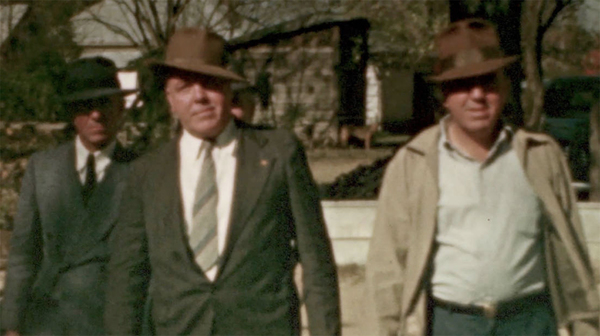presented by San Francisco Cinematheque and San Francisco Museum of Modern Art
in association with theCanyon Cinema Foundation
Admission: $12 general/$10 Cinematheque and SFMOMA members with member code
Advance tickets available here.
Join our Facebook event.
SCREENING
Did You Wonder Who Fired the Gun? (2017) by Travis Wilkerson; digital video, color, sound, 70 minutes, exhibition file from the maker bay area premiere
This West Coast premiere of Did You Wonder Who Fired the Gun? will be presented with live on-stage narration by director Travis Wilkerson.
“...one of the most rigorous and intelligent American documentarians…” (Amy Taubin, Artforum)
"It's hard not to experience Did You Wonder Who Fired the Gun? and not get shivers up your spine—from fear, from anger and from the beauty of Wilkerson's filmmaking.” (Bilge Ebiri, The Village Voice)
In 1946 in Dothan, Alabama, black American Bill Spann was murdered by S.E. Branch, a white southerner, and great-grandfather of filmmaker Travis Wilkerson. Branch suffered no lasting consequences, while Spann’s existence has been all but erased. Wilkerson’s Did You Wonder Who Fired the Gun? is a harrowing, confrontational, deeply personal documentary investigation on this incident, a Southern Gothic murder mystery directly addressing white racism in America, past and present. Including the filmmaker’s family photos, home movies, news reports and documents as well as original interviews and locational photography of the now-haunted locations Branch and Spann inhabited, Did You Wonder… presents a complex and confessional portrait of lingering family legacies of secrecy and shame, a powerful work not to be missed. (Steve Polta)
“William Faulkner’s now-famous observation, “The past isn’t dead. It isn’t even past,” could apply to [Wilkerson’s] An Injury to One (2002), but it is even more apropos to Did You Wonder Who Fired the Gun?, which, like all of Faulkner’s novels, is set in the deep South, in the small town of Dothan, Alabama, where S. E. Branch, a white supremacist and Wilkerson’s great-grandfather, shot and killed a black man named Bill Spann in Branch’s grocery store. Branch was charged with murder, but the case never went to trial and he suffered no consequences. In the opening moments of the piece, Wilkerson explains that the idea to make a film, which would investigate both his great-grandfather and his victim, came when he was at a protest in South Los Angeles after George Zimmerman was acquitted of the murder of Trayvon Martin. “I couldn’t get it out of my head how much the story of Trayvon Martin reminded me of a family legend.” From this protest comes the “Say His/Her Name” chant that Wilkerson uses to mark the film’s chapters. At the end of the piece, Bill Spann’s name is added to the list.
At [the film’s screening at] Sundance, Wilkerson sat to the side of the screen, facing the audience and read aloud the voiceover narration. He told me that at a Creative Capital retreat (Did You Wonder… was largely funded by the grant-giving organization) he presented the film as a work in progress. Since he hadn’t yet mixed his voiceover into the sound track, he read it live as he did at Sundance, and he found that this performance strategy had a powerful effect on both him and the audience. The power has to do with it being a personal story, told in the first-person; in sharing it with an audience, Wilkerson doesn’t let anyone, including himself, off the hook. “This isn’t a white savior story. This is a white nightmare story.”
Grief and anger are palpable in the images, music and texts that make up Did You Wonder Who Fired the Gun? Wilkerson collages family photos (one of himself as an infant on great-granddaddy Branch’s lap), 8mm home movies, photos of documents and newsprint articles, on-camera interviews and, most tellingly, handheld footage from his investigations. There’s the decaying wood structure that was the scene of the crime; the abandoned hospital where Spann died; and the grave in the black cemetery in another town miles away, to which he was directed by an African American clerk after the white woman in charge told him that there’s no record of Spann.
That almost turns out to be the case. All that’s left of Bill Spann is an unmarked grave. His killer, however, does not lack for memorializing images and people who remember him. Many, but not all, of the memories are bad. Wilkerson’s mother is one of three sisters who grew up in the same town as their grandfather. Jean, the eldest, is an active member of the White Supremacist League of the South. Wilkerson’s mother and her sister Jill want nothing to do with her. One of the questions that haunts me weeks after I saw the piece is how to make sense of that difference. How is it that some people escape the racism and misogyny in which they are raised (Branch abused his wife and daughters and likely killed more than one black man) and some cling to it as their reason for existence? Wilkerson doesn’t offer an answer. But raising the question—at this moment when families are torn apart by what they believe America is and should be—is more than enough. (Amy Taubin, “What’s in a Name?” Artforum)
Pictured above: Did You Wonder Who Fired the Gun? (2017) by Travis Wilkerson
CROSSROADS 2017 is generously supported by: National Endowment for the Arts, Fleishhacker Foundation, Grants for the Arts, Zellerbach Family Foundation, George Lucas Family Foundation, Owsley Brown III Philanthropic Foundation and the Willow Foundation.
With thanks to our festival sponsors:

